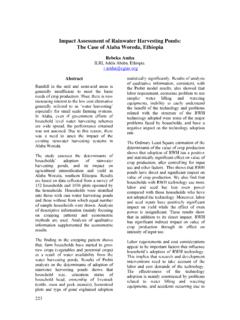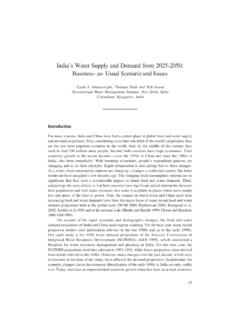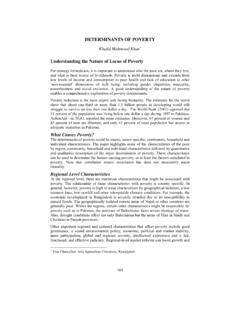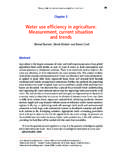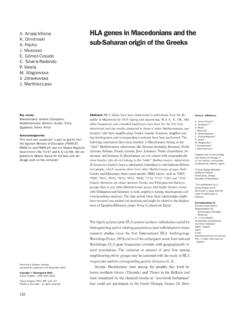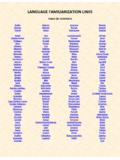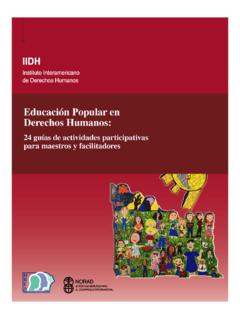Transcription of 9 Indigenous Systems of Conflict Resolution in …
1 9 Indigenous Systems of Conflict Resolutionin Oromia, EthiopiaDesalegn Chemeda Edossa,1 Seleshi Bekele Awulachew,2 Regassa Ensermu Namara,3 Mukand Singh Babel4*and Ashim Das Gupta4**1 Haramaya University, ethiopia ; e-mail: 2 International WaterManagement Institute (IWMI), ILRI- ethiopia campus, Addis Ababa, ethiopia ; e-mail: 3 International Water Management Institute (IWMI), Accra,Ghana; e-mail: 4 Asian Institute of Technology, School of CivilEngineering, Pathumthani, Thailand; *e-mail: **e-mail: chapter describes the role of the gadaasystem, an institution developed for guiding the social, political,economic and religious life of the Oromo people in ethiopia and for managing resources such as water, as wellas its contribution in conflict Resolution among individuals and communities.
2 It discusses ways to overcome thedifference between customary and statutory approaches in conflict Resolution . A synthesis of customary andstatutory Systems of conflict Resolution may facilitate a better understanding that will lead to improved manage-ment of resources, which are predominant variables for the socio-economic development of the country. Itsuggests that top-down imposition and enforcement of statutory laws that replace customary laws should beavoided. Instead, mechanisms should be sought to learn from the Lubas, elders who are knowledgeable in thegadaa system , about the customary mechanisms of conflict Resolution so as to integrate them into the enact-ment or implementation of statutory : gadaa, Indigenous institution, water management, Oromo, conflict Resolution , Borana, ethiopia .
3 CAB International 2007. Community-based Water Law and Water Resource Management146 Reform in Developing Countries (eds B. van Koppen, M. Giordano and J. Butterworth)IntroductionThe water resources endowment of Ethiopiaexhibits tremendous spatial and temporal vari-ability and poses significant development andmanagement challenges. The level of watersupply in ethiopia is among the lowest inAfrica. A great majority of Ethiopians useunsafe and polluted water, and are at risk froma variety of water-borne diseases (Flintan andImeru, 2002). The strong bias towards urbandevelopment means that the provision of watersupplies in rural areas is particularly low.
4 Itsavailability in the dry season is of great concernto the majority of rural populations across thearid and semiarid parts of the country, wherevillagers travel long distances to the nearestsources of water after local sources havebecome exhausted as a result of the prolongeddry season. For example, in the Awash riverbasin, spending 4 6 h on a daily basis forgetting water is not uncommon for a ruralhousehold living far from a river course(Desalegnet al., 2004).In the Dollo and Filtu districts of the Libanzone of the Somali regional state, there is hardlyany perennial source of water between Genaleand Dawa, the two main rivers in that , villagers in places like Filtu must relyon water tankers and boreholes, once thenearby local pond dries out (Ahrens and Farah,1996).
5 These situations apply equally to mostpastoral lands in Oromia, which experience lowannual precipitation, averaging between 400and 700 mm. In many of pastoral areas droughtoccurs on a regular basis. As a result, pastoralland use depends on scarce water supply fromthe rivers and groundwater. Consequently, bothintra- and inter-ethnic conflicts over the use ofnatural resources are commonplace in and Wellard (1997) categorizeconflicts in terms of whether they occur: (i) at themicro micro or micro macro levels, amongcommunity groups or between communitygroups and government; or (ii) within private orcivil society organizations. Micro micro conflictscan be further categorized as taking place eitherwithin the group directly involved in a particularresource management regime ( a forest usergroup or ecotourism association), or between thisgroup and those not directly involved (Conroy etal.)
6 , 1998). For instance, access to water and landresources is the major source of conflicts betweenclans and ethnic groups in the Awash river basinand the Borana zone, while territory is anotherimportant source of conflicts in the of clan territory is more intensenearer to the water source such as the Awashriver, whereas exclusive rights to land are lessimportant farther from the water source, indicat-ing the significance of water resources to thepastoral communities socio-economic illustrative example of micro macroconflicts is found in the Awash basin. A numberof studies have attributed the cause of conflicts inthe Awash river basin to the introduction of vari-ous large-scale irrigation schemes along rivercourses and the opening up of the AwashNational Park on the land predominantly used bypastoralists for grazing during the dry season andduring droughts, which also limited access to keydry-season springs (Flintan and Imeru, 2002).
7 Asa result, competition between pastoralist groupsincreased as they moved in search of pasture andwater supplies. Many of the development projectsin the basin involve investment by internationalorganizations with a top-down approach, bypass-ing the customary laws of the indigenouscommunities. Bassi (2003) presents the feelingsof the local community Karrayu elders about theestablishment of the Awash National Park in theyear 1969 as follows:Haile Selassie [Ethiopian emperor] sent hisministers. They asked us whether we agree to theestablishment of the park or not. Their questionwas not genuine, since they had already taken allthe land without consulting us. It was intended toproduce a pretext to arrest us as usual.
8 We toldthem that we do not give all of our land since wehave no other place, but part of it. We, then,agreed out of fear, obviously, to give the land eastof Fantale Mountain for the park. They agreed togive us land west of the Fantale Mountain. Weaccepted since we could not do anymore. Whenthey prepared a map of the park and began toprotect the land, the thing was different. Theyreversed the agreement. The map of the parkincluded areas west of Fantale Mountain, whichthey previously agreed to give us. They havebegun to evict us. They built a camp in oursettlement areas. We repeatedly asked thegovernment and the park to respect our jointagreement but no one listened to us ..(Karrayu elder, quoted in Buli Edjeta, 2001,p.)
9 86 (cited in Bassi, 2003))Some of the local people gained someeconomic benefits from developments in theAwash valley mainly through employmentopportunities. However, such trends sowed theseeds of further conflict within Afar politicalstructures as a growing Afar capitalist classundermined traditional clan elders. This was afactor in the violent conflict that was manifestedin the Derg1period. The most common inter-clan and inter-ethnic conflicts are between theKarrayu and Ittu Oromo communities and theAfar and Issa communities, the Derg regime, peasant associations(PAs, or kebeles) were the powerful instrumentof formal conflict Resolution . They had their ownjudicial committee to oversee conflicts and hadthe power to impose decisions through fines andimprisonment.
10 Under the current regime, kebeleadministrations (KAs) have been set up, bring-ing together two or three of the former PAs, withsimilar judicial powers to the latter. In addition,governmental teams have been established torepresent a maximum of 50 households, thusIndigenous Systems of Conflict Resolution147bringing state institutions to an even more locallevel. Conflicts relating to natural resourcesmanagement are nowadays often reported tothe governmental teams and, through them, tothe also exist various traditional institu-tions in the country that have their own custom-ary methods of settling conflicts. In this regard,thegadaasystem of conflict Resolution is onethat deserves attention.
